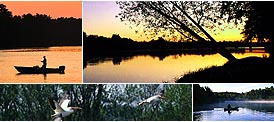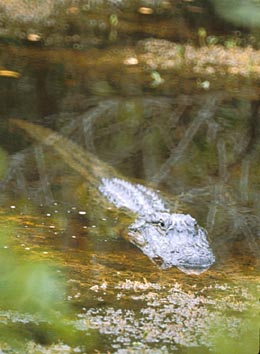
Note: Watch this area for additional navigation information in each section!


Chassahowitzka River
Because of its nearly pristine, natural condition, the Chassahowitzka River is one of the more scenic rivers in Florida. Accessible only by boat or canoe, the Chassahowitzka River is one of the state's Outstanding Florida Waters. Because of its natural importance to Florida, it received this designation and was given special protection to maintain its existing water quality conditions.
Like most of the other rivers in the Springs Coast Watershed, the Chassahowitzka River is spring fed. The first-magnitude Chassahowitzka Springs form the beginning point of the river. Although water quality in the river and springs is generally good, recent studies have shown that nitrate levels have increased and elevated levels of bacteria have been observed in the canal system above the river's headwaters. Leaky septic tanks and excessive fertilizing of landscapes are two ways nitrates can get into the groundwater supply and eventually appear in spring discharge.
The Chassahowitzka National Wildlife Refuge, which borders the Chassahowtizka River, was established in 1943 as a winter preserve for migratory water birds. Today, about 35,000 acres of this area, which includes the Chassahowitzka and Homosassa River estuaries, many islands, 12 miles of river, salt marshes and coastal swamps, are protected and managed by several federal, state and local government agencies. The goal is to offer migrating and wintering water birds a place to rest and feed. Within this area there are 7,500 acres that include habitat for the Florida black bear.
The Southwest Florida Water Management District (District) buys lands that are important to the protection of Florida's water resources. In 1990, the District began acquiring lands that now make up the Chassahowitzka Riverine Swamp Sanctuary. Today, the Sanctuary is made up of about 5,676 acres of land. When combined with federally and locally purchased land in the Chassahowitzka area, a total of 60,348 acres of land along the Chassahowitzka River have been preserved.
The District's Sanctuary includes both uplands and wetlands. Some of the trees and plants you will find in the uplands include sand live oaks, fetterbushes, saw palmettos, longleaf pines and turkey oaks. Some of the wetland plants and trees include cypress trees, cabbage palms, saw grass, sweetgum trees and red maple trees. Many animals also make the sanctuary their home. These animals include Florida black bears, white-tailed deer, bald eagles, river otters, bobcats, ospreys, great blue herons, anhingas, cormorants, wood storks and manatees.
Provded by Southwest Florida Water Management District












